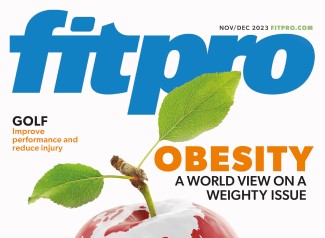Magazine References
Nov – Dec 2023

Pg 6-7 How zero gravity, ageing and inactivity affect the neuromuscular system
References
- Vernikos J (2011), Sitting Kills: Moving Heals, Quill Publishers.
- Hunter et al (2016), The aging neuromuscular system and performance, J App Phys., 121(4): 982-95.
- Walston J (2012), Sarcopenia in older adults, Curr Opin Rheumatol., 24(6): 623-27.
- Power et al (2013), Human neuromuscular structure and old age, J Sport Health, (2): 215-25.
- Vernikos J (2016), Designed to move: The science-backed program to fighting sitting diseases and enjoying lifelong health, Quill Publishers.
Pg 8-11 Obesity: A global perspective on a weighty issue
References
- World Health Organization, Obesity: https://www.who.int/health-topics/obesity#tab=tab_1 Accessed on 2 November 2023.
- World Obesity, Classification: https://www.worldobesity.org/about/about-obesity/obesity-classification Accessed on 2 November 2023.
- Centre of Disease Control, Overweight & Obesity: https://www.cdc.gov/obesity/index.html Accessed on 2 November 2023.
- Caleyachetty R et al (2021), Ethnicity-specific BMI cutoffs for obesity based on type 2 diabetes risk in England: a population-based cohort study, Lancet Diabetes Endocrinol., 9: 419-26.
- South Asian Americans Leading Together, Demographic information: https://saalt.org/south-asians-in-the-us/demographic-information/ Accessed on 2 November 2023.
- Satvinder S (2009), Measurement error and ethnic comparisons of measures of abdominal obesity, Eur J Clin Nutr., 49(2-3): 148-52.
- Seidell J (2007), Waist circumference and waist/hip ratio in relation to all-cause mortality, cancer and sleep apnea, Eur. Heart J., 28(7): 850-56.
- Koning L (2007), Waist circumference and waist-to-hip ratio as predictors of cardiovascular events: meta-regression analysis or prospective studies, Epidemiol Rev., 29: 115-28.
- Vazquez G (2013), Comparison of body mass index, waist circumference and waist/hip ratio in predicting incident diabetes: a meta-analysis, Physiol Rev., 93(1): 359-404.
- OLorenzo A et al (2019), Why primary obesity is a disease, J Transl Med., 10: 1,186.
- The Kings’ Fund, Tacking Obesity Report: The role of the NHS in a whole systems approach: Tackling obesity: the role of the NHS in a whole-system approach (kingsfund.org.uk) Accessed on 2 November 2023.
- Popkin B, Does global obesity represent a global public health challenge? Am J Clin Nutr., 93: 232-33
- Hawkes C (2006), Uneven dietary development linking policies and processes of globalization with nutrition transition, obesity and diet-related chronic diseases, Global Health, 2: 4.
- Mozaffarian D et al (2022), Perspective: Obesity – an unexplained epidemic, Am J Clin Nutr., 115: 1,145- 1,450.
- Yingying et al (2022), Study on the death and disease burden caused by high sugar-sweetened beverages intake in China from 1990 to 2019, 32(5): 773-78.
- Tae J et al (2018), Income and obesity: what is the direction of the relationship? A systematic review and meta-analysis, BMI Open, 8: 019862.
Pg 12-15 Understanding stress and recovery – the key to Fitness 2.0
References
- What is heart rate variability? – Harvard Health Accessed on 2 November 2023.
- www.pillarwellbeing.com Accessed on 2 November 2023.
- The Sleep Heart Health Study: design, rationale, and methods – PubMed (nih.gov) Accessed on 2 November 2023.
- Sleep Deprivation and Deficiency – How Sleep Affects Your Health | NHLBI, NIH Accessed on 2 November 2023.
- Health Information and Medical Information – Harvard Health Accessed on 2 November 2023.
- Philips releases global sleep survey data – News | Philips Accessed on 2 November 2023.
- Is stress keeping you up at night? – The American Institute of Stress Accessed on 2 November 2023.
- Fermented-food diet increases microbiome diversity, decreases inflammatory proteins, study finds | News Center | Stanford Medicine Accessed on 2 November 2023.
Pg 20-23 Unlocking the power of movement variability
References
- Adolph KE, Franchak JM, Wiley (2017), The development of motor behavior, Interdiscip Rev Cogn Sci. 8(1-2): 10.1002/wcs.1430. doi: 10.1002/wcs.1430. Epub 2016 Dec 1. PMID: 27906517; PMCID: PMC5182199.
- Larssen BC, Ho DK, Kraeutner SN, Hodges NJ (2021), Combining observation and physical practice: Benefits of an interleaved schedule for visuomotor adaptation and motor memory consolidation, Front. Hum. Neurosci., 04 February Sec. Motor Neuroscience (2021), 15. https://doi.org/10.3389/fnhum.2021.614452 Accessed on 2 November 2023.
- Otte FW, Millar SK, Klatt S (2019), Skill training periodization in “specialist” sports coaching: An introduction of the “PoST” framework for skill development, Front Sports Act Living, 15(1) :61. doi: https://www.ncbi.nlm.nih.gov/pmc/articles/PMC7739686/ Accessed on 2 November 2023.
- Caramiaux B, Bevilacqua F, Wanderley MM, Palmer C (2018), Dissociable effects of practice variability on learning motor and timing skills, PLoS One, 13(3): e0193580. doi: https://journals.plos.org/plosone/article?id=10.1371/journal.pone.0193580 Accessed on 2 November 2023.
- Werner I, Federolf P (2023), Focus of attention in coach instructions for technique training in sports: A scrutinized review of review studies, J Funct Morphol Kinesiol., 8(1): 7. doi: https://www.mdpi.com/2411-5142/8/1/7 Accessed on 2 November 2023.
- Porter JM, Nolan RP, Ostrowski EJ, Wulf G (2010), Directing attention externally enhances agility performance: A qualitative and quantitative analysis of the efficacy of using verbal instructions to focus attention, Front Psychol., 1: 216. doi: https://www.frontiersin.org/articles/10.3389/fpsyg.2010.00216/full Accessed on 2 November 2023.
- Han Y, Syed Ali SKB, Ji L (2022), Use of observational learning to promote motor skill learning in physical education: A systematic review, Int J Environ Res Public Health, 19(16): 10,109. doi: 10.3390/ijerph191610109 Accessed on 2 November 2023.
- Haar S, Donchin O, Dinstein I (2017), Individual movement variability magnitudes are explained by cortical neural variability, Journal of Neuroscience, 37(37): 9,076-85. doi: 10.1523/JNEUROSCI.1650-17 Accessed on 2 November 2023.
- Dhawale AK, Smith MA, Ölveczky BP (2017), The Role of Variability in Motor Learning Annual Review of Neuroscience, 40(1): 479-98.
- Cowin J, Nimphius S, Fell J (2022), A proposed framework to describe movement variability within sporting tasks: A scoping review, Sports Med – Open, 8: 85. doi: https://doi.org/10.1186/s40798-022-00473-4 Accessed on 2 November 2023.
- Shmuelof L, Krakauer JW, Mazzoni P (2012), How is a motor skill learned? Change and invariance at the levels of task success and trajectory control, J Neurophysiol., 108(2): 578-94. doi: 10.1152/jn.00856.2011. Accessed on 2 November 2023.
- Badets A, Blandin Y (2010), Feedback Schedules for motor-skill learning: The similarities and differences between physical and observational practice, Journal of Motor Behavior, 42: 257-68. doi: 10.1080/00222895.2010.497512. Accessed on 2 November 2023.
Pg 24-27 Yoga for sport
References
- Bergland C, Longer Exhalations are an Easy Way to Hack Your Vagus Nerve, www.psychologytoday.com.
- Alter MJ (1988), The Science of Stretching, Champaign IL: Human Kinetics.
Pg 28-31 Golf: Improve performance and reduce injury
References
- GolfMonthly.com. Jeff Kimber (Editor). Number of UK Golfers Almost Doubles In Five Years. [https://www.golfmonthly.com/news/number-of-uk-golfers-almost-doubles-in-five-years] Accessed on 2 November 2023.
- Goddard D (2016), Personal Interview, Dallas, Texas.
- Golding LA, Golding SM (2003), Fitness professional’s guide to musculoskeletal anatomy and human movement, Monterey, CA: Healthy Learning.
- Chek P (1994), Scientific Back Training. Correspondence Course. La Jolla, CA: Paul Chek Seminars.
- Myers TW (2008), Anatomy trains: Myofascial meridians for manual and movement therapists (2nd edition), New York, Churchill Livingstone.
- Chasan N (2002), Total conditioning for golfers: The swing reaction system biomechanical golf fitness program, Bellevue: Sports Reaction Productions.
- Price J, Bratcher M (2019), The BioMechanics Method corrective exercise specialist certification program, (2nd edition), San Diego, CA: The BioMechanics Press.
- Chek P (1992), Scientific Abdominal Training: Correspondence Course. La Jolla, CA: Paul Chek Seminars.
- Bradley N (2013), 7 Laws of the Golf Swing, New York, Abrams.
- Cook G (2010), Movement, Aptos, California, On Target Publications.
- Petty N, Moore AP (2002), Neuromusculoskeletal examination and assessment: A handbook for therapists, Edinburgh: Churchill Livingstone.
- American Council on Exercise (2010), ACE Personal Trainer Manual (Fourth Edition), American Council on Exercise.
- Rolf IP (1989), Rolfing: Reestablishing the natural alignment and structural integration of the human body for vitality and well-being (revised edition), Rochester, VT: Healing Arts Press.
- Price J (2013), The amazing tennis ball back pain cure, San Diego: The BioMechanics Press.
- Woods T (2001), How I Play Golf, London: Little, Brown and Company.
Pg 32 The role of strength training in triathlon performance
References
- Haugen T, Sandbakk Ø, Seiler S, Tønnessen E (2022), The training characteristics of world-class distance runners: An integration of scientific literature and results-proven practice, Sports Medicine-Open, 8(1): 1-8.
- van Der Zwaard S, Brocherie F, Jaspers RT (2021), Under the hood: Skeletal muscle determinants of endurance performance, Frontiers in Sports and Active Living, 3: 719434.
- Dolci F, Hart NH, Kilding A, Chivers P, Piggott B, Spiteri T (2018), Movement economy in soccer: Current data and limitations, Sports, 6(4): 124.
- Šuc A, Šarko P, Pleša J, Kozinc Ž (2022), Resistance exercise for improving running economy and running biomechanics and decreasing running-related injury risk: A narrative review, Sports, 10(7): 98.
- Lauersen JB, Andersen TE, Andersen LB (2018), Strength training as superior, dose-dependent and safe prevention of acute and overuse sports injuries: A systematic review, qualitative analysis and meta-analysis, British Journal of Sports Medicine, 52(24): 1,557-63.
- Santisteban KJ, Lovering AT, Halliwill JR, Minson CT (2022), Sex differences in VO2max and the impact on endurance-exercise performance, International Journal of Environmental Research and Public Health, 19(9): 4,946.
- Paavolainen LM, Nummela AT, Rusko HK (1999), Neuromuscular characteristics and muscle power as determinants of 5-km running performance, Medicine and Science in Sports and Exercise, 31(1): 124-30.
- Beattie K, Kenny IC, Lyons M, Carson BP (2014), The effect of strength training on performance in endurance athletes, Sports Medicine, 44: 845-65.
- Blagrove RC, Howatson G, Hayes PR (2018), Effects of strength training on the physiological determinants of middle-and long-distance running performance: A systematic review, Sports Medicine, 48: 1,117-49.
- Jung AP (2003), The impact of resistance training on distance running performance, Sports Medicine,33: 539-52.
- Barnes KR, Kilding AE (2015), Strategies to improve running economy, Sports Medicine, 45: 37-56.
- Crowley E, Harrison AJ, Lyons M (2017), The impact of resistance training on swimming performance: A systematic review, Sports Medicine, 47: 2,285-307.
- Saunders PU, Pyne DB, Telford RD, Hawley JA (2004), Factors affecting running economy in trained distance runners, Sports Medicine, 34: 465-85.
- Bonacci J, Chapman A, Blanch P, Vicenzino B (2009), Neuromuscular adaptations to training, injury and passive interventions: Implications for running economy, Sports Medicine, 39: 903-21.
- Denadai BS, de Aguiar RA, de Lima LC, Greco CC, Caputo F (2017), Explosive training and heavy weight training are effective for improving running economy in endurance athletes: A systematic review and meta-analysis, Sports Medicine, 47 :545-54.
- Vikmoen O, Rønnestad BR (2021), A comparison of the effect of strength training on cycling performance between men and women, Journal of Functional Morphology and Kinesiology, 6(1): 29.
- Vikmoen O, Ellefsen S, Trøen Ø, Hollan I, Hanestadhaugen M, Raastad T, Rønnestad BR (2016), Strength training improves cycling performance, fractional utilization of VO2max and cycling economy in female cyclists, Scandinavian Journal of Medicine & Science in Sports, 26(4): 384-96.
- Luckin-Baldwin KM, Badenhorst CE, Cripps AJ, Landers GJ, Merrells RJ, Bulsara MK, Hoyne GF (2021), Strength training improves exercise economy in triathletes during a simulated triathlon, International Journal of Sports Physiology and Performance, 16(5): 663-73.
- Lum D, Barbosa TM (2019), Effects of strength training on Olympic time-based sport performance: A systematic review and meta-analysis of randomized controlled trials, International Journal of Sports Physiology and Performance, 14(10): 1,318-30.
- Luckin KM, Badenhorst CE, Cripps AJ, Landers GJ, Merrells RJ, Bulsara MK, Hoyne GF (2021), Strength training in long-distance triathletes: Barriers and characteristics, The Journal of Strength & Conditioning Research, 35(2): 495-502.
- Yamamoto LM, Lopez RM, Klau JF, Casa DJ, Kraemer WJ, Maresh CM (2008), The effects of resistance training on endurance distance running performance among highly trained runners: A systematic review, The Journal of Strength & Conditioning Research, 22(6): 2,036-44.
- Alcaraz-Ibañez M, Rodríguez-Pérez M (2018), Effects of resistance training on performance in previously trained endurance runners: A systematic review, Journal of Sports Sciences, 36(6): 613-29.
- Berthoin S, Baquet G, Mantéca F, Lensel-Corbeil G, Gerbeaux M (1996), Maximal aerobic speed and running time to exhaustion for children 6 to 17 years old, Pediatric Exercise Science, 8(3): 234-44.


